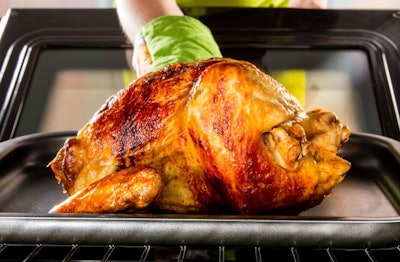
U.S. production of chicken steadily increased over the past two decades while turkey production remained relatively flat.
That insight, along with others about the U.S. chicken and turkey market, were shared as part of WATT Global Media’s April 24, 2019, webinar, “WATTAgnet Top Company webinar: 2019 US broiler and turkey producer rankings.” The webinar is available to view, for free, on demand.
The webinar reviewed WATT PoultryUSA’s 2019 Top Company data, its profiles of the top poultry companies and the historical performance of the industries. The most recent data set can be viewed in the March 2019 issue of the magazine.
Chicken industry's change over time
Historical performance from 2013, 2008 and 1998 was reviewed as part of the webinar. For the chicken industry, there was a notable growth in overall production of millions of pounds of ready-to-cook (RTC) chicken produced on a weekly basis.
In 2018, the most recent year for which data is available, the 29 integrated broiler companies that compose WATT PoultryUSA’s top companies produced a total 904.1 million pounds of chicken. By comparison, in 1998 only 581.7 million pounds – or 64.3 percent of 2018’s production - was produced by a total of 46 companies.
In 1998, the top five chicken companies were: Tyson Foods Inc., with 120 million pounds of ready-to-cook chicken produced on a weekly basis; Gold Kist Inc., with 53.3 million pounds; Perdue Foods, with 45.3 million pounds; Pilgrim’s Pride Corp., with 34.6 million pounds and ConAgra Poultry Co., with 31.8 million pounds.
In 2018, the top five were: Tyson, with 192.33 million pounds of ready-to-cook chicken produced on a weekly basis; Pilgrims, with 156.02 million pounds; Sanderson Farms, with 86.6 million pounds; Perdue, with 64.42 million pounds and Koch Foods Inc., with 50 million.
The growth in production, and industry consolidation, continued in 2013 and 2008. In 2013, the 35 integrators included in the top companies produced 784.5 million pounds of chicken, or 86.7 percent of 2018’s production. In 2008, the 38 companies included in the survey produced 735.6 million pounds of RTC, or about 81.4 percent of 2018’s production.
Turkey industry change over time
While there was an increase in turkey production during the same time period, the growth was not as substantial as it was in the broiler industry.
In 2018, the top 22 turkey companies produced a total of 7.408 billion pounds of live turkeys. By comparison, 26 companies produced a total of 6.675 billion pounds of live turkeys in 1998. That’s about 90.1 percent of what the turkey industry produced in 2018.
In 1998, the top five turkey companies were: Jennie-O Foods, producing 855 million live pounds; Butterball, 840 million pounds; Wampler Foods, 619 million pounds; Cargill, 588 million pounds and Carolina Turkeys, with 455 million pounds.
In 2018, the top five were: Butterball, with 1.331 billion pounds of live turkeys produced; Jennie-O Turkey Store, with 1.230 billion; Cargill Protein, with 950 million; Farbest Foods, with 635 million and Tyson Foods, with 368 million.
In 2013, 23 companies produced a total of 7.019 billion total live pounds of turkeys, or about 94.7 of what the industry produced in 2018. In 2008, 24 companies produced 7.403 billion total live pounds, or about 99.9 percent of what was produced in 2018.


















